Toyota Corolla (E120) 2002–2008 Repair Manual / Diagnostics / Sfi system / Oxygen sensor circuit no activity
detected / Inspection procedure
Toyota Corolla (E120): Inspection procedure
Hint
: hand–held tester only: narrowing down the trouble area is possible by performing ”a/f control” active test (heated oxygen sensor or other trouble areas can be distinguished).
- Perform active test using hand–held tester (a/f control).
Hint
: ”a/f control” is the active test which changes the injection volume to –12.5 % Or +25 %.
- Connect the hand–held tester to the dlc3 on the vehicle.
- Turn the ignition switch on.
- Warm up the engine by running the engine speed at 2,500 rpm for approximately 90 seconds.
- Select the item ”diagnosis / enhanced obd ii / active test / a/f control”.
- Perform ”a/f control” with the engine in an idle condition (press the right or left button).
Result:
heated oxygen sensor reacts in accordance with increase and decrease of
injection volume
+25 % rich output: more than 0.5 V,
–12.5 % Lean output: less than 0.4 V
Notice
: there is a delay of few seconds in the sensor 1 (front sensor) output, and there is about 20 seconds delay at maximum in the sensor 2 (rear sensor).
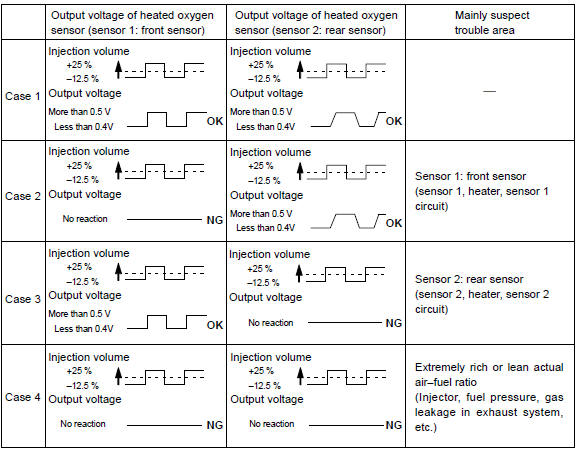
The following of a/f control procedure enables the technician to check and graph the voltage outputs of both the heated oxygen sensors.
For displaying the graph indication, enter ”active test / a/f control / user data”, then select ”o2s b1s1 and o2s b1s2” by pressing ”yes” button and push ”enter” button before pressing ”f4” button.
Hint
:
- if different dtcs related to different systems that have terminal e2 as the ground terminal are output simultaneously, terminal e2 may be open.
- Read freeze frame data using the hand-held tester or the obd ii scan tool. Freeze frame data records the engine conditions when a malfunction is detected. When troubleshooting, it is useful for determining whether the vehicle was running or stopped, the engine was warmed up or not, the air–fuel ratio was lean or rich, etc. At the time of the malfunction.
- A high heated oxygen sensor (sensor 1) voltage (0.5 V or more) could
be caused by a rich air fuel mixture.
Check for conditions that would cause the engine to run rich.
- A low heated oxygen sensor (sensor 1) voltage (0.4 V or less) could
be caused by a lean air fuel mixture.
Check for conditions that would cause the engine to run lean.
1 Check other dtc output(in addition to dtc p0134)
- Connect the hand–held tester or the obd ii scan tool to the dlc3.
- turn the ignition switch on and push the hand–held tester or the obd ii scan tool main switch on.
- select the item ”diagnosis / enhanced obd ii / dtc info / current codes”.
- read the dtcs.
Result:

Hint
: if any other codes besides p0134 are output, perform the troubleshooting for those dtcs first.


2 Read value of hand–held tester or obd ii scan tool(output voltage of heated oxygen sensor)
- Connect the hand–held tester or the obd ii scan tool to the dlc3.
- turn the ignition switch on and push the hand–held tester or the obd ii scan tool main switch on.
- select the item ”diagnosis / enhanced obd ii / data list / all / o2s b1s1”.
- warm up the engine to the normal operating temperature above 75 c (169 f).
- read the output voltage of the heated oxygen sensor when the engine speed is suddenly increased.
Hint
: quickly accelerate the engine to 4,000 rpm 3 times by using the accelerator pedal.
Standard: heated oxygen sensor outputs a rich signal (0.45 V or more) at least once.


3 Check connection of pcv hose


4 Inspect heated oxygen sensor(heater resistance)
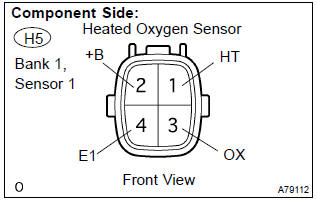
- Disconnect the h5 heated oxygen sensor connector.
- measure the resistance between the terminals of the heated oxygen sensor connector.
Standard:

- Reconnect the heated oxygen sensor connector.


5 Inspect efi relay
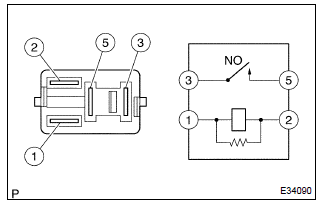
- Remove the efi relay from the engine room r/b.
- check for continuity in the efi relay.
Standard:

- Install the efi relay.


6 Check harness and connector(heated oxygen sensor – ecm)
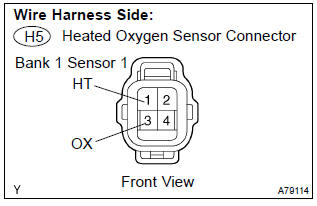
- Disconnect the h5 heated oxygen sensor connector.
- disconnect the e4 ecm connector.
- check the resistance between the wire harness side connectors.
Standard (check for open):

Standard (check for short):

- Reconnect the ecm connector.
- reconnect the heated oxygen sensor connector.
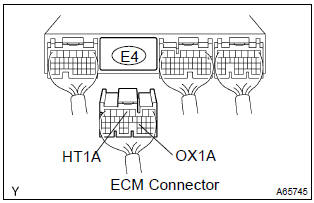
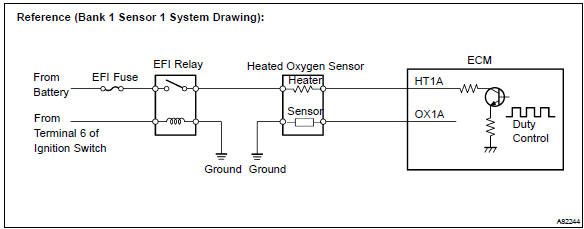


7 Check whether misfire is occurred or not by monitoring dtc and data list


8 Check air induction system
- Check the air induction system for vacuum leaks.


9 Check fuel pressure
- Check the fuel pressure (high or low pressure).


10 Inspect fuel injector assy(injection and volume)


11 Check for exhaust gas leaks


Replace heated oxygen sensor
12 Perform confirmation driving pattern
Hint
: clear all dtcs prior to performing the confirmation pattern.

13 Read output dtc(dtc p0134 is output again)
- Connect the hand–held tester or the obd ii scan tool to the dlc3.
- turn the ignition switch on and push the hand–held tester or the obd ii scan tool main switch on.
- select the item ”diagnosis / enhanced obd ii / dtc info / current codes”.
- read the dtcs.
Result:



14 Confirm if vehicle has run out of fuel in past


Dtc is caused by running out of fuel
Other materials:
Instrument panel/meter
Preparation
Sst
Recomended tools
Equipment
Seat
Preparation
Equipment
Theft deterrent & door lock
Preparation
Recomended tools
...
What to do if... (Troubleshooting)
If there is a problem with the hands-free system or a Bluetooth® device, first
check the table below.
► When using the hands-free system with a
Bluetooth® device
► When registering/connecting a cellular
phone
► When making/receiving a call
► When using the p ...
Correct use of the seat
belts
Extend the shoulder belt so
that it comes fully over the
shoulder, but does not come
into contact with the neck or
slide off the shoulder.
Position the lap belt as low as
possible over the hips.
Adjust the position of the
seatback. Sit up straight and
well back in the seat.
Do not twist ...


